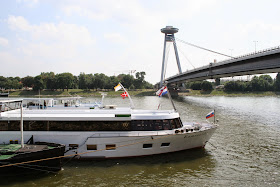I think it has to be one of my favorite capitals and cities in Europe. I like big cities, but I also really like small cities, and that's what Bratislava is. It was a relatively minor provincial city (although the capital of the Communist Slovak Republic) for the past 50 years until the breakup of the USSR), and after that it rocketed to fame as the new country's capital city.

What is there to see? I think you shouldn't miss the massive square brick of a castle on the top of the hill, if not for the castle itself but for the great views over the river and the old town. It was a Roman frontier post from the 1st to the 5th Centuries, and the seat of the Hungarian royalty until it burnt down in 1811. The Historical Museum is inside (including an Ice Hockey Hall of Fame) as well as a Museum of Folk Music.

Slovakia's multiple changes throughout history echo through its capital, from imperial grandeur (it was the capital of Hungary from 1541 to 1830 while the Ottomans controlled Buda), suburban housing projects (of its communist days), multiple Roma, to its current EU pizzazz.
 What is its history? Although a Roman outpost first, the city itself was founded in 907 AD, and it was quite substantial by the 12th Century with commerce developing in the 14th and 15th Centuries. Renaissance monarch Matthias Corvinus of Hungary founded a university here in 1467 (the Academia Istropolitana), and because it was Hungary's capital, so also saw 11 Hungarian kings and 7 queens crowned. Maria Theresa of Austria built many baroque palaces, and it only became part of Czechoslovakia after 1918.
What is its history? Although a Roman outpost first, the city itself was founded in 907 AD, and it was quite substantial by the 12th Century with commerce developing in the 14th and 15th Centuries. Renaissance monarch Matthias Corvinus of Hungary founded a university here in 1467 (the Academia Istropolitana), and because it was Hungary's capital, so also saw 11 Hungarian kings and 7 queens crowned. Maria Theresa of Austria built many baroque palaces, and it only became part of Czechoslovakia after 1918.
 Lonely Planet claims new arrivals on a wet day will be faced with a grey, imposing, one-dimensional city, and that the old city is meagre, but I claim otherwise.
Lonely Planet claims new arrivals on a wet day will be faced with a grey, imposing, one-dimensional city, and that the old city is meagre, but I claim otherwise.
What did I love most? -- I think aside from the beautiful uber-clean pedestrianized streets of the center with their pretty painted colors my favorite thing of all was all the statues - they are everywhere, and then there are also street performers pretending to be the famous statues! If that's not enough there are also multiple fountains around town as well (Ganymede's Fountain built in 1888, Roland's Fountain built in 1572, etc, etc). The most famous statues are The Peeper (coming out of a manhole on Panska), The Frenchman (leaning on a park bench on Hlavne nam), and The Photographer (guarding a corner on Laurinska).
Not all statues are made of metal!
Street performers mimicking the city's famous statues!

What is there to see? I think you shouldn't miss the massive square brick of a castle on the top of the hill, if not for the castle itself but for the great views over the river and the old town. It was a Roman frontier post from the 1st to the 5th Centuries, and the seat of the Hungarian royalty until it burnt down in 1811. The Historical Museum is inside (including an Ice Hockey Hall of Fame) as well as a Museum of Folk Music.

Slovakia's multiple changes throughout history echo through its capital, from imperial grandeur (it was the capital of Hungary from 1541 to 1830 while the Ottomans controlled Buda), suburban housing projects (of its communist days), multiple Roma, to its current EU pizzazz.
 What is its history? Although a Roman outpost first, the city itself was founded in 907 AD, and it was quite substantial by the 12th Century with commerce developing in the 14th and 15th Centuries. Renaissance monarch Matthias Corvinus of Hungary founded a university here in 1467 (the Academia Istropolitana), and because it was Hungary's capital, so also saw 11 Hungarian kings and 7 queens crowned. Maria Theresa of Austria built many baroque palaces, and it only became part of Czechoslovakia after 1918.
What is its history? Although a Roman outpost first, the city itself was founded in 907 AD, and it was quite substantial by the 12th Century with commerce developing in the 14th and 15th Centuries. Renaissance monarch Matthias Corvinus of Hungary founded a university here in 1467 (the Academia Istropolitana), and because it was Hungary's capital, so also saw 11 Hungarian kings and 7 queens crowned. Maria Theresa of Austria built many baroque palaces, and it only became part of Czechoslovakia after 1918. Lonely Planet claims new arrivals on a wet day will be faced with a grey, imposing, one-dimensional city, and that the old city is meagre, but I claim otherwise.
Lonely Planet claims new arrivals on a wet day will be faced with a grey, imposing, one-dimensional city, and that the old city is meagre, but I claim otherwise.
They did say however that Bratislava is a "youthful city, bursting with big ideas and fresh optimism" which I do agree with.
Only an hour away from Vienna (#911) down the Danube, it is just as much in the heart of Europe, but on it's Eastern heart instead of it's Western heart.
Only an hour away from Vienna (#911) down the Danube, it is just as much in the heart of Europe, but on it's Eastern heart instead of it's Western heart.
The unique Michael's Tower looks over Bratislava from Zamocnicka alley.
Source: Lonely Planet Eastern Europe 8th Edition 2005
































No comments:
Post a Comment